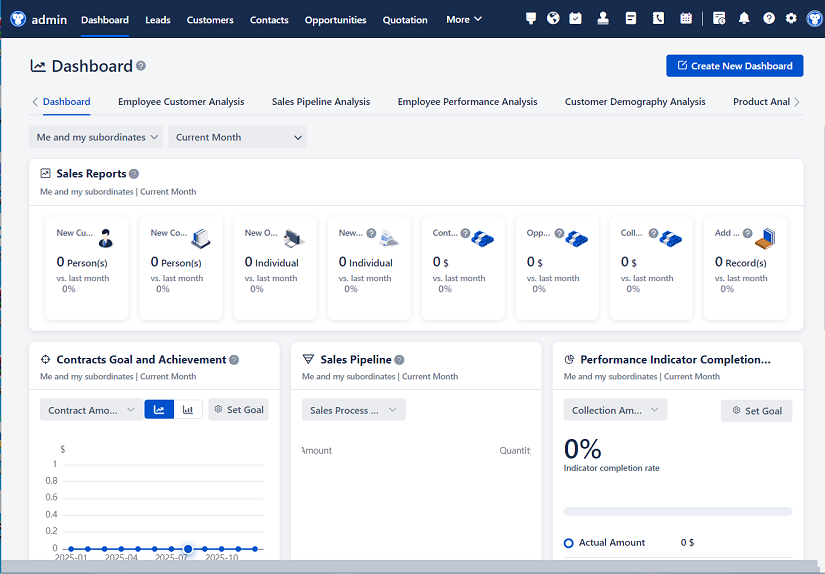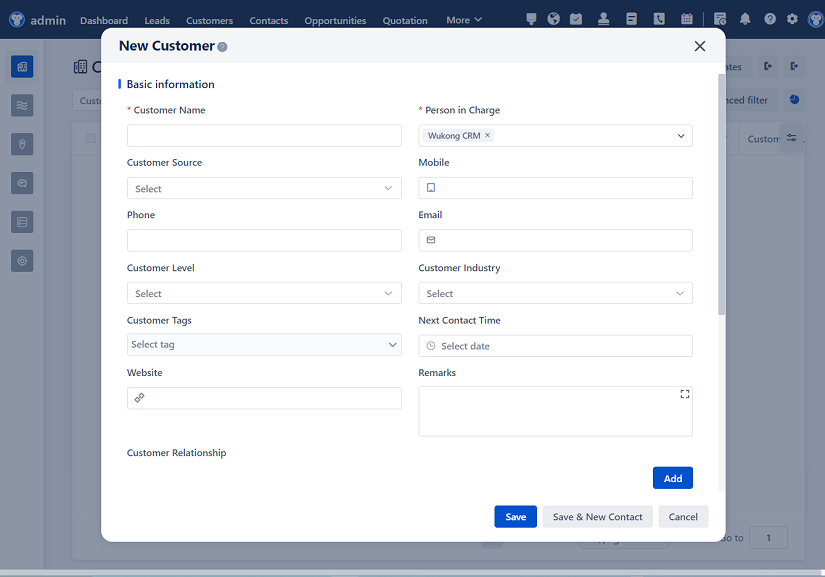
△Click on the top right corner to try Wukong CRM for free
Hey there! So, you're looking to dive into the world of CRM (Customer Relationship Management) and need a bit of guidance on how to put together a solid CRM Requirements Document? Well, you've come to the right place. Let's chat about it in a way that feels like we're just having a casual conversation over coffee.
First things first, let's talk about why this document is so important. You see, when you're trying to pick out the perfect CRM system for your business, it's kind of like shopping for a new car. You wouldn't just walk into a dealership and point at the first shiny thing you see, right? No, you'd have a list of what you need: maybe good gas mileage, or a sunroof, or enough space for the kids. A CRM Requirements Document is exactly that—a list of all the features and functionalities you need from a CRM system to make sure it fits your business like a glove.
Now, before we get too deep into the nitty-gritty, let's take a step back and think about who should be involved in creating this document. It's not just an IT thing; it's a team effort. You'll want to gather input from different departments—sales, marketing, customer service, and even finance. Each of these teams has a unique perspective on what they need from a CRM, and their insights are invaluable. Think of it as a brainstorming session where everyone gets to share their thoughts and ideas. It's like planning a big family vacation—everyone's got their own preferences, and you want to make sure everyone's happy with the final destination.
Alright, so now that we've got our team assembled, let's start by defining the purpose of the CRM. What do you want to achieve with this system? Are you looking to improve customer retention, streamline your sales process, or maybe just get a better handle on your customer data? Whatever it is, write it down. This will be the North Star that guides the rest of your requirements. For example, if your main goal is to boost customer retention, you might focus on features that help you track customer interactions and provide personalized experiences. If it's about streamlining the sales process, then you might prioritize automation and integration with other tools your sales team uses.

Next up, let's talk about the must-haves. These are the non-negotiables, the features that your CRM absolutely needs to have. Maybe you need a system that can integrate with your existing email platform, or one that supports multiple languages because you have a global customer base. Or perhaps you need robust reporting and analytics to keep an eye on key performance indicators. Whatever it is, make sure you list them out clearly. It's like making a grocery list before you head to the store—you don't want to forget the milk or bread, right?
But hey, we can't just stop at the must-haves. There are also the nice-to-haves, those features that would be great to have but aren't deal-breakers. Maybe you'd love a CRM that offers AI-powered chatbots, or one that has a mobile app for your field sales team. These are the cherry-on-top features that can make your life easier, but you could still live without them if push comes to shove. It's like when you're ordering pizza—pepperoni is a must, but extra cheese is a nice bonus.
Now, let's not forget about the technical requirements. This is where you get into the nitty-gritty of how the CRM will work within your existing tech stack. Do you need it to integrate with specific software or platforms? What about security and compliance? If you're in a regulated industry, you'll need to make sure the CRM meets all the necessary standards. And don't forget about scalability—will the CRM grow with your business, or will you need to switch to a new system in a few years? It's like making sure your new car can handle the long road trips you plan to take, not just the daily commute.
Another important aspect to consider is user experience. The last thing you want is a CRM that's so complicated that no one wants to use it. Make sure the system is intuitive and easy to navigate. Think about the training and support you'll need to get your team up and running. Will the vendor provide training, or will you need to bring in external experts? And what about ongoing support? You don't want to be left hanging if something goes wrong. It's like buying a new gadget—sure, it looks cool, but if you can't figure out how to use it, it's not going to be very helpful.
Speaking of vendors, let's talk about the selection process. Once you've got your requirements all laid out, it's time to start looking at different CRM options. You'll want to create a shortlist of potential vendors and then evaluate each one based on how well they meet your needs. This is where you can get into the details—pricing, implementation timelines, and any additional costs. It's like test-driving different cars to see which one feels right. Don't be afraid to ask for demos and trials, and make sure you involve your team in the decision-making process. After all, they're the ones who will be using the system day in and day out.
Finally, let's talk about the timeline. Implementing a new CRM isn't something you can do overnight. You'll need to plan out the entire process, from selecting the vendor to rolling out the system to your team. Set realistic deadlines and milestones, and make sure you have a clear plan for data migration and training. It's like planning a big move—there's a lot to do, and you need to stay organized to make sure everything goes smoothly.

So, there you have it—a quick and casual guide to putting together a CRM Requirements Document. It might seem like a lot, but trust me, taking the time to do it right will pay off in the long run. You'll end up with a CRM that truly works for your business, and that's worth every bit of effort.
Q&A:
Q: Why is it important to involve different departments in creating the CRM Requirements Document? A: Well, think of it this way—each department has its own unique needs and perspectives. Sales might need a CRM that integrates with their existing tools, while customer service might need robust case management features. By involving everyone, you ensure that the CRM you choose will meet the needs of the whole organization, not just one team.
Q: How do I decide between must-have and nice-to-have features? A: Good question! Must-haves are the features that are essential for your business to function. Nice-to-haves are those that would be great to have but aren't critical. To decide, ask yourself: "Can we operate without this feature?" If the answer is no, it's a must-have. If it's yes, it's a nice-to-have.
Q: What should I look for in terms of user experience when choosing a CRM? A: User experience is super important. You want a CRM that's intuitive and easy to use. Look for a clean, user-friendly interface, and make sure the system offers good training and support. If your team finds it difficult to use, they won't, and that defeats the whole purpose.
Q: How do I ensure the CRM I choose is scalable? A: Scalability is key, especially if you're a growing business. When evaluating CRMs, ask the vendor about their ability to handle increased data, more users, and additional features as your business grows. Also, check if they offer different pricing tiers or plans that can accommodate your future needs.
Q: What's the best way to involve my team in the CRM selection process? A: Involving your team is crucial. Start by gathering their input on what they need from a CRM. Then, include them in the demo and trial phases. Let them test the system and provide feedback. Finally, involve them in the decision-making process. Their buy-in and enthusiasm will make the transition much smoother.
I hope this helps, and good luck with your CRM journey!
Related links:
Free trial of CRM
Understand CRM system
AI CRM Systems

△Click on the top right corner to try Wukong CRM for free